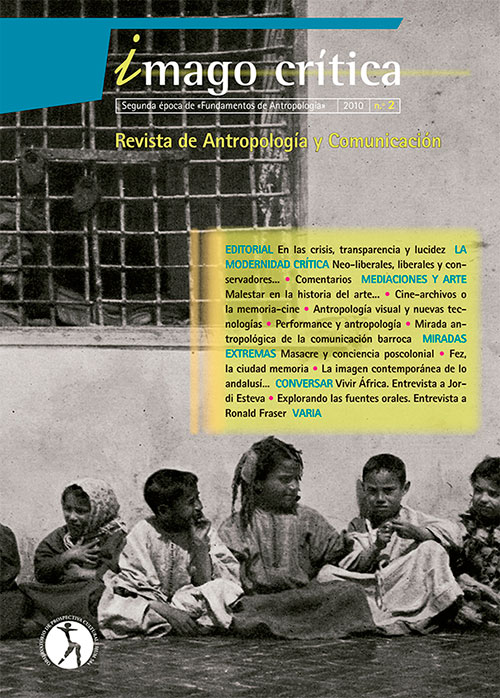Malestar en la historia del arte: sobre la antropología de las imágenes de Hans Belting y Georges Didi-Huberman
Palabras clave:
arte, antropología, historiografía del arte, Hans Belting, Georges Didi-HubermanResumen
El presente artículo se propone analizar el “giro antropológico” que en las últimas décadas ha venido teniendo lugar en el ámbito de la historiografía del arte. Para ello, se toma como elemento común la puesta en cuestión de la noción moderna de representación, lo que David Summers llama el “representacionalismo filosófico moderno”. Posteriormente, se analiza en mayor detalle la antropología de las imágenes postulada por los dos representantes de ese giro más ligados a la tradición historiográfica continental, Hans Belting y Georges Didi-Huberman, así como su explícita filiación en la iconología de Aby Warburg.
Citas
BELTING, Hans (1983), L’histoire de l’art est-elle finie?, París: Gallimard, 1989.
BELTING, Hans (1995), Art History after modernism, Chicago/Londres: The University of Chicago Press, 2003.
BELTING, Hans (2001), Pour une anthropologie des images, París: Gallimard, 2004
BELTING, Hans (2005), “Image, Medium, Body. A New Approach to Iconology”, Critical Inquiry, 31, invierno de 2005,
CESTELLI GUIDI, Benedetta (ed.), (2008), Storia dell’arte e antropología, Ricerche di Storia dell’Arte, n.º 94, 2008.
CLIFFORD, James (1988) The predicament of culture. Twentieth-Century Ethnography, Literature and Art, Cambridge (Mass.): Harvard University Press.
DANTO, Arthur (1994), “The End of Art”, en LANG, Berel (ed.), The end of art, Art and philosophy, vol. 2, Nueva York: Haven Publications, pp. 5-35.
DIDI-HUBERMAN, Georges (1992), Ce que nous voyons, ce qui nous regarde, París: Minuit.
DIDI-HUBERMAN, Georges (2007), L’image ouverte. Motifs de l’incarnation dans les arts visuels, París: Gallimard, 2007.
ELKINS, James (2006), “On David Summers’s Real Spaces”, en James Elkins, Is Art History Global?, Londres: Taylor & Francis, 2006, pp. 41-70.
FOSTER, Hal (1996), The Return of the Real. The Avant-garde at the End of the Century, Cambridge (Mass.): The MIT Press.
FREEDBERG, David (1989), The Power of Images: Studies in the History and Theory of Response, Londres/Chicago: University of Chicago Press.
FREEDBERG, David; GALLESE, V. (2007), “Motion, emotion and empathy in aesthetic experience”, Trends in cognitive science, 11, 5, mayo de 2007, pp. 197-203.
GELL, Alfred (1998), Art and agency, Oxford: Oxford University Press.
MITCHELL, W.J.T. (1986), Iconology. Image, text, ideology, Londres/Chicago: University of Chicago Press, 1986.
OSBORNE, r.; TANNER, J. (eds.), (2007), Art’s agency and art history. New Interventions in Art History, Oxford: Blackwell Publishing.
SEVERI, Carlo (ed.), (2003), “Image et anthropologie”, L’homme, n.º 165, enero-marzo de 2003.
SUMMERS, David (1993), “Representation”, en Robert S. Nelson, Richard Shiff, Critical terms for art History, Chicago/Londres: The University of Chicago Press, 1993, pp. 3-20.
SUMMERS, David (2003), Real Spaces: World Art History and The Rise of Western modernism, Londres: Phaidon Press, 2003.
VV.AA. (1996), “Visual Culture Questionnaire”, October, vol. 77, Cambridge (Mass.): The MIT Press, 1996, pp. 25-70.
VV.AA. (2005), Anthropologies of Art, Williamstown, MA: Sterling and Francine Clark Art Institute.
VV.AA. (2007), “Le moment du Quai Branly”, Le débat, n.º 147, noviembre-diciembre de 2007
Descargas
Publicado
Número
Sección
Licencia

Esta obra está bajo una licencia internacional Creative Commons Atribución-NoComercial-CompartirIgual 4.0.












